In 2017, iStar received just under 40 percent support for its executive compensation package, but turned it around with 94 percent support the following year.
Jason Fooks, senior vice president of investor relations and marketing at iStar and Safehold, says:
Failing a say-on-pay vote is frustrating and disappointing, but it also forced us to consider the needs and objectives of a large shareholder constituency we had clearly neglected: index funds and other corporate governance-focused institutional investors. They are largely passive investors that generally aren’t making buy and sell decisions based on our business performance, and we had historically spent little time communicating and building relationships with them. Turning the vote around was a six-month process that involved a cross-functional team and, critically, an active leadership role taken by the board.
As we began this process, we realized our failed say-on-pay vote wasn’t about requiring a wholesale change to our approach to compensation or even restructuring our long-term incentive plans. Rather, we needed to better communicate how the plans aligned with shareholders and the measures the board used to determine how much was allocated and to whom.
Our first step was to engage with our corporate governance-focused investors in the off-season (fourth quarter). Members of our board were involved in each of those meetings. To prepare, we worked with the board and outside consultants to build a presentation that shared a framework for some of our preliminary governance and compensation considerations. In addition, our goal during these meetings was to create an opportunity to hear candid feedback. Many investors were very forthcoming, fair and helpful.
None of which is to say you should ignore your active investor base in this process because it may also have strong feelings about compensation. In fact, we proactively sought out its views on compensation and other governance matters. We highlighted in our proxy the percentage of our shareholder base we had engaged with – a key metric many corporate governance-focused shareholders find important.
When it came to drafting our proxy statement, we went to considerable lengths to elevate the document and turn it into an effective communication tool – similar to an annual report – rather than just a regulatory SEC filing. It included plain English explanations, graphics and charts combined with a professional design to help communicate our message as clearly and simply as possible.
Finally, once our proxy was filed, we arranged for follow-up meetings with certain key shareholders and the proxy solicitation firms in order for members of the board to be able to highlight the changes we made and share how investor feedback was incorporated.
The result was a strong vote – and a very happy board.
This article appeared in the Fall 2020 issue of IR Magazine. To continue reading, click here to open the full digital edition of IR Magazine










